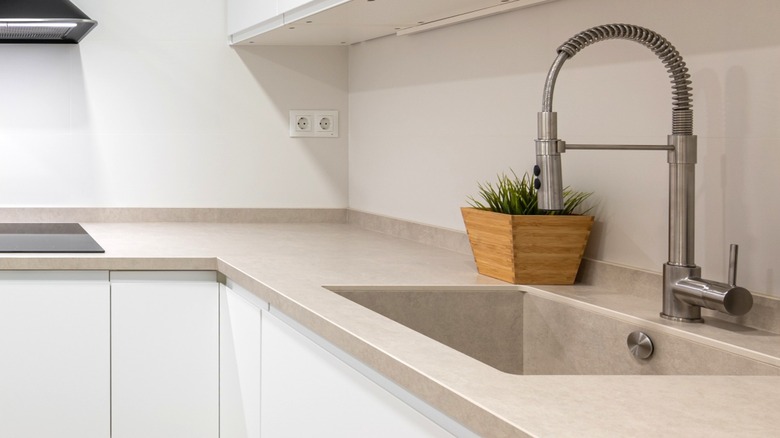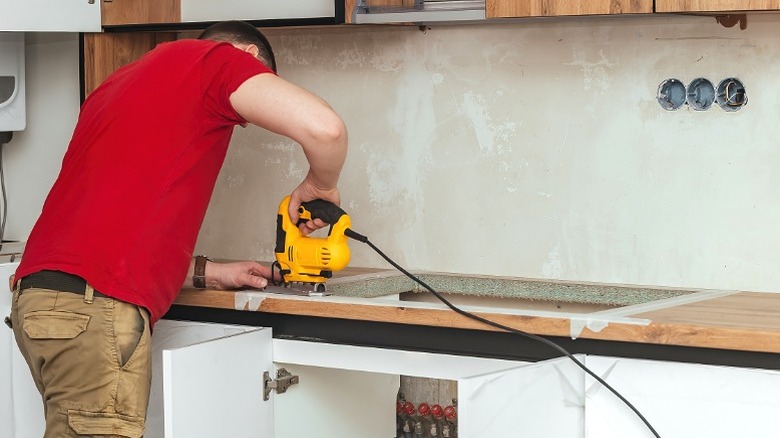Can You Really Build A Fully Integrated Sink With Leftover Countertop Materials?
There's a two-part process that starts most DIYs — we get enthusiastic envisioning a neat project to make life better around the home, and then we take stock of whether it's possible and practical. When you see a hack as cool as an integrated sink using leftover countertop materials, like the elegant design from Instagrammer @rootddesignstudio, the first part is easy. A super-stylish, high-end kitchen fixture sans the high cost — who wouldn't want that? But once the excitement over the finished product eases and you gradually come back to earth, the uncertainty of this build becomes all too clear. It's a sink, after all, so any missteps could lead to water leaks and extensive damage from mold or rot. Before long, an inexpensive DIY can turn into thousands of dollars worth of repairs.
With so much at stake, we turned to House Digest's expert carpenter and remodeler, Bob Beacham, for a professional's take on whether a fully integrated sink hack is possible for a DIYer using leftover countertop materials. As he explained, there are issues at just about every phase. Compare it to the typical way of making these sinks, and this approach turns out to be one of the more dubious DIYs. "There's no suggestion they did it themselves," Beacham stated in his exclusive chat. "I'm not convinced about the leftovers thing either, at least not in the way we're led to believe. Industry standard practice is to charge for a full sheet, however much is actually used." Beacham elaborated that while this particular project seems impractical, there are a few potential (though challenging) ways to make it work.
When can you DIY an integrated sink with countertop pieces?
With this integrated sink being an extension of the surrounding surface, a major consideration is the countertop style. Many affordable countertop materials, such as laminate or wood, make a fine prep surface but a horrible choice for a basin. "In theory, you could cut and dowel or biscuit joint solid hardwood offcuts and seal the edges, but I'm sure they would eventually leak," Beacham stated in his exclusive interview with House Digest. "The wood would need to be finished in polyurethane to protect it, and even then you could never pour boiling water on it. You'd have to avoid any kind of harsh household chemicals like bleach, vinegar, or abrasive cleaners. I've seen carved wood sinks for use in bathrooms, but IMHO a kitchen is a no-go."
When you compare the durability of countertop materials in an integrated sink design, Beacham said there's a clear choice. "The ONLY viable material is some kind of stone (quartzite is used in the vid)," he asserted. Though workable, these materials also put your tools, skills, and confidence to the test. At the least, you'd likely need a specialty stone or tile saw for safe, clean, and precise cuts, an expensive item outside the typical set of tools every homeowner should have. "An angle grinder could cut the material, but not with anything like the required accuracy. Stonemasons would do most of the cutting using a big, overhead saw with a constant water feed for cooling."
Why this hack isn't DIY-friendly (and a better alternative)
Cutting the pieces is demanding enough, but that's only one of many challenges when designing a fully integrated kitchen sink. "Bear in mind someone's also got to cut the hole in the countertop," Beacham explained in his House Digest exclusive. "I'm guessing using a diamond core drill bit and an angle grinder? That's how I would do it with a normal sink, but with them you have the sink lip to hide any small errors." As he described it, even the pros can struggle with such a unique hack. And that's provided you have the right tools. "Cutting with the degree of accuracy required here is beyond me. A workshop router could maybe do most of it, but not the sharp corners."
Even after successful cuts, the next hurdle is creating a strong, watertight seal. "Modern construction adhesive might do it," Beacham noted. "The pros recommend specialist adhesive specific to the type of stone. It would need to be clamped and supported while the adhesive cured."
Add it all up, and the result is hardly worth the aggravation for most DIYers. "Integrated sinks are usually bought preinstalled in the countertop, not fitted later as a separate project. Perhaps it was designed that way from the get go rather than added as an afterthought," Beacham suggested. If you love the look, though, he offered an alternative requiring more basic tools like a router and clamps. "Flushmount sinks aren't necessarily cheap, but they create a not dissimilar look for way less than this. That could be a viable DIY option for someone with the right tools."

